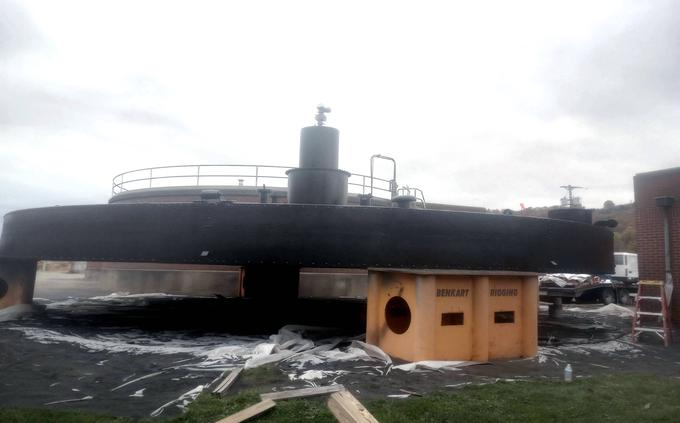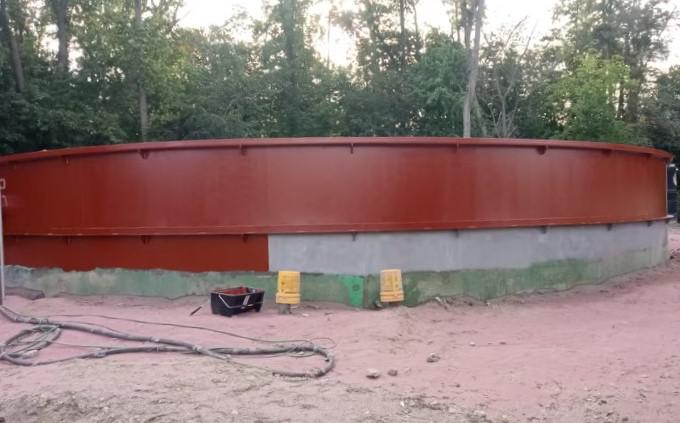Wastewater Tank Painting and Linings
Protecting and maintaining private and public wastewater treatment plants is another one of our specialties here at MPC. We offer wastewater tank painting and lining services for a variety of wastewater tanks and infrastructure across Ohio as well as USA-wide.
These include:
Fermenters, Digesters, Sludge Thickener Tanks, Clarifiers, Containment Tanks, Denitrification Pools, Distribution Tanks, Rake Assemblies, Collection Systems, and Pump Houses.
Wastewater Treatment Plants (also known as Water Treatment Works or Sewage Treatment Plants) are continuously exposed to extremely harsh corrosive environments. The sand and solids passed through this process can create significant abrasion, wearing down the tanks and linings, and hydrogen sulfide corrosion can deteriorate tank headspaces.
When a lining fails, the steel or concrete substrates can lead to catastrophic levels of corrosion very quickly, creating a repair bill exponentially more costly than what a new liner or lining maintenance would be.
Send Your Request And Get A Free Quote


Why Choose Us?
Nationwide Tank Painting
Over 5000 Tanks Restored
Preferred Contractor
Accident Free Safety Record
Best-In-Class Warranties
Zero Downtime Process
100% Eco-Friendly
Anywhere In The USA




























Restoring Wastewater Treatment Plants
We provide several approaches to protecting wastewater tanks including Epoxies, Glass-Mat Reinforced Linings, Vinyl-Ester Linings, Poly Linings and others.
Epoxy Liners
Epoxy liners serve as a cost-effective and reliable solution for wastewater tank linings. Characterized by their thin mil application, typically ranging from 10-12 mils, these coatings are highly resistant to abrasion, ensuring durability in high-wear environments. Epoxy liners are also adept at withstanding a range of chemical exposures, including basic solutions like sodium hydroxide and extremely diluted acids. This resistance makes them a versatile choice for tanks containing a variety of substances. Additionally, the relative simplicity of their application process, combined with their economic benefits, makes epoxy liners a popular choice for many wastewater treatment facilities. They provide a balance of protection and affordability, making them a standard option in tank lining systems.
Polyurea Liners
Polyurea is a leading choice for wastewater tank linings, known for its rapid curing time (6-8 seconds) and adherence to complex shapes. It's typically applied at a thickness of 60-80 mils, significantly thicker than the 10-12 mils common for epoxy. Its adaptability makes it ideal for coating irregular surfaces like poles and pumps. Polyurea's standout feature is its flexibility, boasting over 2,000 psi tensile strength and 300% elongation. This elasticity is a major advantage over epoxy and similar rigid coatings, which may crack under stress. Polyurea's ability to expand and contract without cracking makes it suitable for both steel and concrete structures. Additionally, its quick curing and strong tensile strength enable it to repair tank holes as part of the lining process.
Glass-Mat Reinforced Linings
Glass-Mat Reinforced linings excel in secondary containment and immersion service tank lining applications. The inclusion of glass mat reinforcement enhances structural integrity, raises temperature thresholds, extends service life, and adds an additional corrosion-resistant layer. This type of lining is particularly effective on concrete, offering crack bridging capabilities.
Vinyl-Ester Linings
Available in single coats ranging from six to 40 mils, vinyl ester linings are highly effective against corrosion, particularly in acid-rich and high-temperature environments. They also come with options for abrasion resistance and Low Surface Energy (LSE) coatings, enhancing their utility in challenging conditions.
Importance of Tank Linings
Tank interiors are often coated with lining materials that offer resistance to corrosion, owing to the nature of the specific components in the system.
This task is highly specialized and necessitates an experienced and competent contractor, one with expertise in surface preparation, ventilation, managing environmental conditions, coating application, cure time, and most importantly, employee safety.
Let’s talk about your Wastewater Tank Painting Project - send your request now!
Wastewater Tank Painting - Your Curious Queries
The longevity of wastewater tank lining varies significantly, typically ranging from three to five years for less durable options. The lifespan is influenced by multiple factors such as the quality of substrate preparation, the type of material used, the caliber of the installation, and the operational conditions of the tank. With meticulous installation and maintenance, a high-quality tank lining can effectively serve for over 15 years.
If a wastewater tank lining sustains damage, rest assured, it can be repaired. The specific repair method employed will depend on both the severity and location of the damage. Small cracks or punctures can often be repaired with a patch (or sprayed with additional polyurea and flattened with teflon putty knife) while larger or more significant areas of damage may require more extensive repairs before applying the new lining.
Wastewater tank lining offers several advantages, such as preventing leaks and spills, shielding the tank from corrosion and damage, extending the tank’s lifespan, minimizing facility downtime, averting extensive corrosion-related repair costs, and reducing the risk of environmental contamination.
